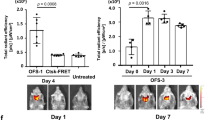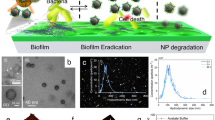Abstract
Dental calculi can cause gingival bleeding and periodontitis, yet the mechanism underlying the formation of such mineral build-ups, and in particular the role of the local microenvironment, are unclear. Here we show that the formation of dental calculi involves bacteria in local mature biofilms converting the DNA in neutrophil extracellular traps (NETs) from being degradable by the enzyme DNase I to being degradation resistant, promoting the nucleation and growth of apatite. DNase I inhibited NET-induced mineralization in vitro and ex vivo, yet plasma DNases were ineffective at inhibiting ectopic mineralization in the oral cavity in rodents. The topical application of the DNA-intercalating agent chloroquine in rodents fed with a dental calculogenic diet reverted NET DNA to its degradable form, inhibiting the formation of calculi. Our findings may motivate therapeutic strategies for the reduction of the prevalence of the deposition of bacteria-driven calculi in the oral cavity.
This is a preview of subscription content, access via your institution
Access options
Access Nature and 54 other Nature Portfolio journals
Get Nature+, our best-value online-access subscription
$29.99 / 30 days
cancel any time
Subscribe to this journal
Receive 12 digital issues and online access to articles
$99.00 per year
only $8.25 per issue
Buy this article
- Purchase on Springer Link
- Instant access to full article PDF
Prices may be subject to local taxes which are calculated during checkout








Similar content being viewed by others
Data availability
The main data supporting the results of this study are available within the paper and its Supplementary Information. The raw and analysed datasets generated during the study are available for research purposes from the corresponding author on reasonable request.
Change history
02 April 2024
A Correction to this paper has been published: https://doi.org/10.1038/s41551-024-01203-9
References
Tasian, G. E. et al. Annual incidence of nephrolithiasis among children and adults in South Carolina from 1997 to 2012. Clin. J. Am. Soc. Nephrol. 11, 488–496 (2016).
White, D. J. Dental calculus: recent insights into occurrence, formation, prevention, removal and oral health effects of supragingival and subgingival deposits. Eur. J. Oral Sci. 105, 508–522 (1997).
Jepsen, S., Deschner, J., Braun, A., Schwarz, F. & Eberhard, J. Calculus removal and the prevention of its formation. Periodontol. 2000 55, 167–188 (2011).
Krisdapong, S., Prasertsom, P., Rattanarangsima, K., Sheiham, A. & Tsakos, G. The impacts of gingivitis and calculus on Thai children’s quality of life. J. Clin. Periodontol. 39, 834–843 (2012).
Rule, A. D. et al. The ROKS nomogram for predicting a second symptomatic stone episode. J. Am. Soc. Nephrol. 25, 2878–2886 (2014).
Hong, I. et al. Clinical and microbiological efficacy of pyrophosphate containing toothpaste: a double-blinded placebo-controlled randomized clinical trial. Microorganisms 8, 1806 (2020).
Vaernewyck, V., Arzi, B., Sanders, N. N., Cox, E. & Devriendt, B. Mucosal vaccination against periodontal disease: current status and opportunities. Front. Immunol. 12, 768397 (2021).
Lee, H. et al. Dental calculi of Siberian Natives, Russian Settlers, and Korean People of Joseon Dynasty Period in the 16th to 19th Century Eurasia Continent. BioMed. Res. Int. 2022, 5765604 (2022).
Hazen, S. P. Supragingival dental calculus. Periodontol. 2000 8, 125–136 (1995).
Kambalyal, P., Kambalyal, P. & Hungund, S. Comparison of salivary calcium level in smokers and non-smokers with chronic periodontitis, aggressive periodontitis, and healthy controls. J. Int. Soc. Prev. Community Dent. 5, S68–S73 (2015).
Albandar, J. M. et al. Gingival state and dental calculus in early-onset periodontitis. J. Periodontol. 67, 953–959 (1996).
Akcali, A. & Lang, N. P. Dental calculus: the calcified biofilm and its role in disease development. Periodontol. 2000 76, 109–115 (2018).
Schapher, M. et al. Neutrophil extracellular traps promote the development and growth of human salivary stones. Cells 9, 2139 (2020).
Munoz, L. E. et al. Neutrophil extracellular traps initiate gallstone formation. Immunity 51, 443–450.e4 (2019).
Haq Sikder, M. N., Itoh, M., Iwatsuki, N. & Shinoda, H. Inhibitory effect of a novel bisphosphonate, TRK-530, on dental calculus formation in rats. J. Periodontol. 75, 537–545 (2004).
Niu, L. N. et al. Collagen intrafibrillar mineralization as a result of the balance between osmotic equilibrium and electroneutrality. Nat. Mater. 16, 370–378 (2017).
Jiao, K. et al. Complementarity and uncertainty in intrafibrillar mineralization of collagen. Adv. Funct. Mater. 26, 6858–6875 (2016).
Shen, M. J. et al.Extracellular DNA: a missing link in the pathogenesis of ectopic mineralization. Adv. Sci. 9, 2103693 (2022).
Hakkim, A. et al. Impairment of neutrophil extracellular trap degradation is associated with lupus nephritis. Proc. Natl Acad. Sci. USA 107, 9813–9818 (2010).
Lemos, J. A. et al. The biology of Streptococcus mutans. Microbiol. Spectr. 7, GPP3-0051-2018 (2019).
Buzzo, J. R. et al. Z-form extracellular DNA is a structural component of the bacterial biofilm matrix. Cell 184, 5740–5758.e17 (2021).
Bezanilla, M. et al. Motion and enzymatic degradation of DNA in the atomic force microscope. Biophys. J. 67, 2454–2459 (1994).
Suck, D. & Oefner, C. Structure of DNase I at 2.0 Å resolution suggests a mechanism for binding to and cutting DNA. Nature 321, 620–625 (1986).
Ramesh, N. & Brahmachari, S. K. Structural alteration from non-B to B-form could reflect DNase I hypersensitivity. J. Biomol. Struct. Dyn. 6, 899–906 (1989).
Kim, S. H. et al. Unveiling the pathway to Z-DNA in the protein-induced B–Z transition. Nucleic Acids Res. 46, 4129–4137 (2018).
Kwakye-Berko, F. & Meshnick, S. Sequence preference of chloroquine binding to DNA and prevention of Z-DNA formation. Mol. Biochem. Parasitol. 39, 275–278 (1990).
Pires, R. H., Felix, S. B. & Delcea, M. The architecture of neutrophil extracellular traps investigated by atomic force microscopy. Nanoscale 8, 14193–14202 (2016).
Haider, P. et al. Neutrophil extracellular trap degradation by differently polarized macrophage subsets. Arterioscler. Thromb. Vasc. Biol. 40, 2265–2278 (2020).
Domer, D. et al. Neutrophil extracellular traps activate proinflammatory functions of human neutrophils. Front. Immunol. 12, 636954 (2021).
Jimenez-Alcazar, M. et al. Host DNases prevent vascular occlusion by neutrophil extracellular traps. Science 358, 1202–1206 (2017).
Roberts-Harry, E. A. & Clerehugh, V. Subgingival calculus: where are we now? A comparative review. J. Dent. 28, 93–102 (2000).
Brinkmann, V. et al. Neutrophil extracellular traps kill bacteria. Science 303, 1532–1535 (2004).
Akcali, A. & Lang, N. P. Dental calculus: the calcified biofilm and its role in disease development. Periodontol. 2000 76, 109–115 (2018).
Surma, S. et al. Periodontitis, blood pressure, and the risk and control of arterial hypertension: epidemiological, clinical, and pathophysiological aspects—review of the literature and clinical trials. Curr. Hypertens. Rep. 23, 27 (2021).
He, J. Y. et al. The Janus nature of nanohydroxyapatite in tumor progression. Adv. Funct. Mater. 32, 2107599 (2022).
Schumski, A. et al. Endotoxinemia accelerates atherosclerosis through electrostatic charge-mediated monocyte adhesion. Circulation 143, 254–266 (2021).
Reznikov, N. et al. A materials science vision of extracellular matrix mineralization. Nat. Rev. Mater. 1, 16041 (2016).
Li, B. et al. NETosis in psoriatic arthritis: serum MPO–DNA complex level correlates with its disease activity. Front. Immunol. 13, 911347 (2022).
Najmeh, S., Cools-Lartigue, J., Giannias, B., Spicer, J. & Ferri, L. E. Simplified human neutrophil extracellular traps (NETs) isolation and handling. J. Vis. Exp. 16, e52687 (2015).
Datsenko, K. A. & Wanner, B. L. One-step inactivation of chromosomal genes in Escherichia coli K-12 using PCR products. Proc. Natl Acad. Sci. USA 97, 6640–6645 (2000).
Zhang, Y. et al. Production of d-xylonate from corn cob hydrolysate by a metabolically engineered Escherichia coli strain. ACS Sustain. Chem. Eng. 7, 2160–2168 (2018).
Gutiérrez-Venegas, G., Guadarrama-Solís, A., Muñoz-Seca, C. & Arreguín-Cano, J. A. Hydrogen peroxide-induced apoptosis in human gingival fibroblasts. Int. J. Clin. Exp. Pathol. 8, 15563 (2015).
Kargarpour, Z. et al. Platelet-rich fibrin can neutralize hydrogen peroxide-induced cell death in gingival fibroblasts. Antioxidants 9, 560 (2020).
Yang, L. et al. DNA of neutrophil extracellular traps promotes cancer metastasis via CCDC25. Nature 583, 133–138 (2020).
Acknowledgements
This work was supported by the National Clinical Research Center for Oral Diseases (LCA202004), National Natural Science Foundation of China (no. 82325012 to Li-na Niu and no. 82170978 to K.J.), the Shaanxi Key Scientific and Technological Innovation Team (no. 2020TD-033 to Li-na Niu). Parts of the figures were drawn using pictures from Servier Medical Art. Servier Medical Art by Servier is licenced under a Creative Commons Attribution 3.0 Unported License (https://creativecommons.org/licences/by/3.0).
Author information
Authors and Affiliations
Contributions
M.W., K.J., Yi-na Zhu and Q.W. contributed to the study design, data acquisition and interpretation. Yi-peng Zhang contributed to the DNA manipulation of Escherichia coli. Long-zhang Niu, C.L. and J.S. contributed to data analysis and interpretation. W.L. and Z.R. performed the animal experiments. H.L. provided the clinical samples. F.T. refined the paper. Li-na Niu developed the concept and supervised experiments. All authors contributed to writing the paper.
Corresponding author
Ethics declarations
Competing interests
The authors declare no competing interests.
Peer review
Peer review information
Nature Biomedical Engineering thanks Martin Herrmann, Sunita Ho and the other, anonymous, reviewer(s) for their contribution to the peer review of this work.
Additional information
Publisher’s note Springer Nature remains neutral with regard to jurisdictional claims in published maps and institutional affiliations.
Supplementary information
Supplementary Information
Supplementary figures, tables and references.
Rights and permissions
Springer Nature or its licensor (e.g. a society or other partner) holds exclusive rights to this article under a publishing agreement with the author(s) or other rightsholder(s); author self-archiving of the accepted manuscript version of this article is solely governed by the terms of such publishing agreement and applicable law.
About this article
Cite this article
Wan, Mc., Jiao, K., Zhu, Yn. et al. Bacteria-mediated resistance of neutrophil extracellular traps to enzymatic degradation drives the formation of dental calculi. Nat. Biomed. Eng (2024). https://doi.org/10.1038/s41551-024-01186-7
Received:
Accepted:
Published:
DOI: https://doi.org/10.1038/s41551-024-01186-7



